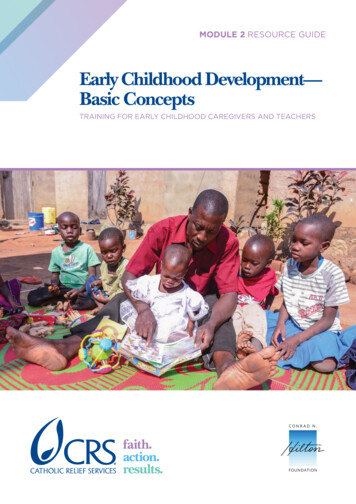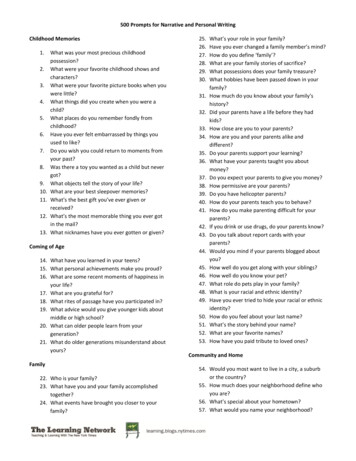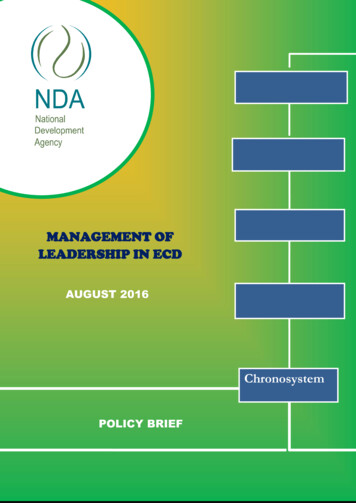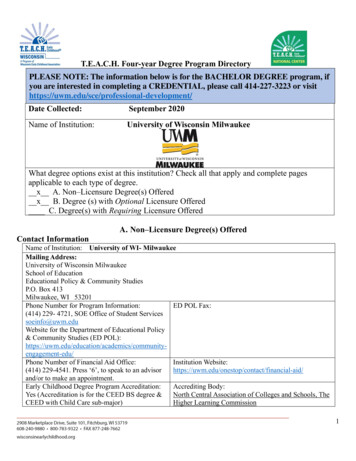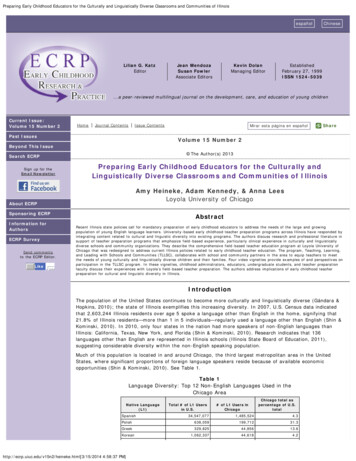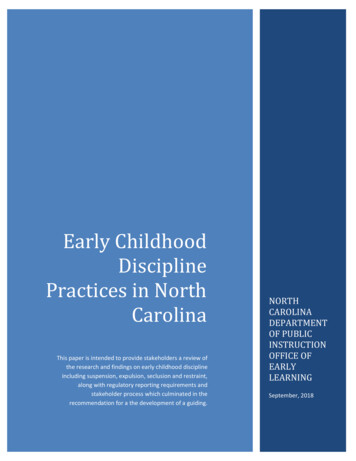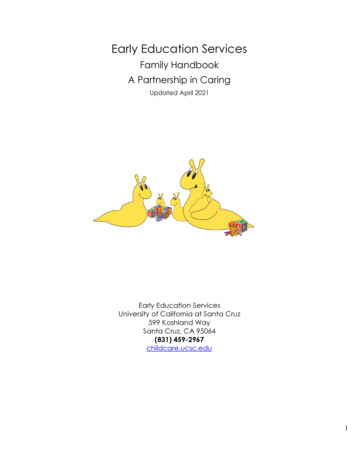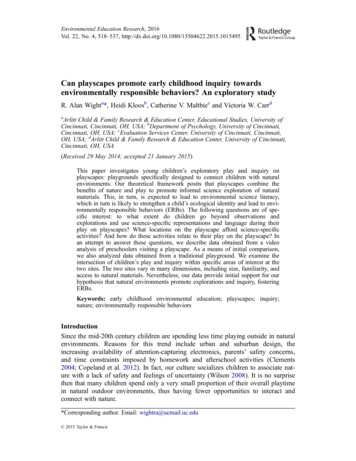
Transcription
Environmental Education Research, 2016Vol. 22, No. 4, 518–537, http://dx.doi.org/10.1080/13504622.2015.1015495Can playscapes promote early childhood inquiry towardsenvironmentally responsible behaviors? An exploratory studyR. Alan Wighta*, Heidi Kloosb, Catherine V. Maltbiec and Victoria W. CarrdaArlitt Child & Family Research & Education Center, Educational Studies, University ofCincinnati, Cincinnati, OH, USA; bDepartment of Psychology, University of Cincinnati,Cincinnati, OH, USA; cEvaluation Services Center, University of Cincinnati, Cincinnati,OH, USA; dArlitt Child & Family Research & Education Center, University of Cincinnati,Cincinnati, OH, USA(Received 29 May 2014; accepted 21 January 2015)This paper investigates young children’s exploratory play and inquiry onplayscapes: playgrounds specifically designed to connect children with naturalenvironments. Our theoretical framework posits that playscapes combine thebenefits of nature and play to promote informal science exploration of naturalmaterials. This, in turn, is expected to lead to environmental science literacy,which in turn is likely to strengthen a child’s ecological identity and lead to environmentally responsible behaviors (ERBs). The following questions are of specific interest: to what extent do children go beyond observations andexplorations and use science-specific representations and language during theirplay on playscapes? What locations on the playscape afford science-specificactivities? And how do these activities relate to their play on the playscape? Inan attempt to answer these questions, we describe data obtained from a videoanalysis of preschoolers visiting a playscape. As a means of initial comparison,we also analyzed data obtained from a traditional playground. We examine theintersection of children’s play and inquiry within specific areas of interest at thetwo sites. The two sites vary in many dimensions, including size, familiarity, andaccess to natural materials. Nevertheless, our data provide initial support for ourhypothesis that natural environments promote explorations and inquiry, fosteringERBs.Keywords: early childhood environmental education; playscapes; inquiry;nature; environmentally responsible behaviorsIntroductionSince the mid-20th century children are spending less time playing outside in naturalenvironments. Reasons for this trend include urban and suburban design, theincreasing availability of attention-capturing electronics, parents’ safety concerns,and time constraints imposed by homework and afterschool activities (Clements2004; Copeland et al. 2012). In fact, our culture socializes children to associate nature with a lack of safety and feelings of uncertainty (Wilson 2008). It is no surprisethen that many children spend only a very small proportion of their overall playtimein natural outdoor environments, thus having fewer opportunities to interact andconnect with nature.*Corresponding author. Email: wightra@ucmail.uc.edu 2015 Taylor & Francis
Environmental Education Research519As environmental educators have demonstrated, this lack of connection to nature,which Louv (2008) labeled ‘nature-deficit disorder,’ has important ramifications forour children and society (Clements 2004). Outdoor play in nature (OPiN) not onlysupports healthy physical development, but also stimulates cognitive and emotionaldevelopment, namely by providing physical and mental challenges that encourageproblem solving, critical thinking, team work, creative play, and risk taking(Cole-Hamilton, Harrop, and Street 2002; Fjørtoft 2001; Frost 2006; Heft 1998;Moore 1985a, 1985b; Sallis, Prochaska, and Taylor 2000).In an effort to address the problems of decreased OPiN, a new kind of playground has been developed, one that combines the best of natural environments withthe safety and convenience of enclosed: the playscape. Playscapes are intentionallydesigned play areas that aspire to connect children to water, soil, trees, and looseparts typically found in nature (Carr and Luken 2014; Fjørtoft 2001; Talbot andFrost 1989). They encourage creativity, imagination, and an affinity toward nature(Ernst 2014; Luken, Carr, and Brown 2011; Moore 1985a). Here we focus on yetanother benefit of playscapes: their potential to foster inquiry and exploration, aprerequisite toward environmentally responsible behaviors (ERBs).Environmentally responsible behaviorPro-environmental and ERB promotes ecological sustainability through a relationship with nature (Nisbet, Zelenski, and Murphy 2009). It captures an ecologicalethic of sorts that translates into respect, appreciation, and an understanding ofnature that can foster a love of place (Eagles and Demare 1999; Ewert, Place, andSibthorp 2005; Gruenewald and Smith 2014; Jensen 2002; Sobel 1996; White2004). Free play in a natural setting can strengthen positive motivations for ERBand reduce negative associations toward nature, especially if their experiences withnature are positive (Cohen and Horm-Wingerd 1993; Malone and Tranter 2003).To promote ERB in children, a crucial factor is an exposure to nature that provides them with opportunities to explore, understand, and participate in the world ontheir own terms (Ballantyne and Packer 1996, 2005; Kaplan 2000; Wells and Lekies2006). In the current study, we investigate the extent to which playscapes can elicitsplay and inquiry relevant to science and environmental learning. Indeed, theintersection between free play, science-related inquiry, nature, and ERBs taps intochildren’s innate curiosity, self-motivation, enjoyment, and fun (Falk 2005). Thus,rather than measuring children’s attitudes toward nature (cf. Leeming et al. 1997),we chose to observe their science inquiry and explorations related to nature. Figure 1shows our theoretical framework about how the benefits of both nature andplaygrounds promote a kind of exploration that is likely to support ERB and thedevelopment of a child’s environmental identity (The following references align withthe specific arrows and domains in Figure 1: Wells and Lekies 2006; White 2004;Ballantyne and Packer 2005; Falk 2005; Luken, Carr, and Brown 2011; Falk 2005;Nisbet, Zelenski, and Murphy 2009; Ballantyne and Packer 1996; Jensen 2002).Measuring preschoolers’ science inquiryDocumenting the degree of knowledge acquisition, inquiry, and learning that occursduring OPiN is challenging. There are proven methods for describing and analyzingtypes and duration of play (e.g. Miller and Almon 2009; Parten 1933; Piaget 1962;
520R.A. Wight et al.Figure 1. Theoretical framework of how playscapes support ERB through informal scienceexploration.Rubin, Watson, and Jambor 1978; Sandseter 2009; Smilansky 1968). Yet, for ourpurposes, a deeper understanding of content requires qualitative measures that provide rich details into behaviors. We thus turn to video and audio recordings to captureplay and code behaviors from numerous perspectives (cf. Hart and Sheehan 1986).There are several science-based assessments for informal learning environments(Chermayeff, Blandford, and Losos 2002; for a review see Kloos et al. 2012; Martin2004; Orion et al. 1997; Worch and Haney 2011). These methods enable scholars toevaluate the degree of relevant behaviors that occur during play (Hickling andWellman 2001; Kurth et al. 2002; Vantaggi 2011). Building upon these studies, wecompared children’s behavior on a playscape environment with children’s behavioron a school playground. Differences between these two sites are at the heart of thisstudy, as we seek further insight into how these distinct settings impact the type ofchildren’s play, science exploration, and ERB.Overview of activitiesWe observed one group of preschoolers on a playscape and another group of preschoolers on their school’s playground. Teachers at each location were asked to letthe children play freely, with minimal adult interactions. Trained videographers
Environmental Education Research521recorded children’s free play and exploratory behaviors at both sites, focusing ondocumenting activities that were suggestive of science inquiry into nature. We thencoded and analyzed the video footage.MethodsStudy participantsOur sample for this project was drawn from four classrooms at a MidwesternUniversity laboratory preschool in the United States. The preschool serves low tomedium socioeconomic status families, with income at or below the poverty linebeing eligible for Head Start education. The sample consisted of 64 childrenbetween the ages of 3 and 5. One group of 32 preschoolers (ten qualifying for HeadStart) was observed three times on the playscape. Another group of 32 children(19 qualifying for Head Start) was observed three times on their playground. Table 1contains the demographic details for both groups.Research sitesThere were two different data collection sites for this project: the Charles and MargeSchott Nature PlayScape at Cincinnati Nature Center (CNC) and the playground atthe laboratory preschool. The CNC PlayScape is a 1.6 acre, fenced area within a1000 acre nature preserve. It contains a natural forest, open prairies, a recirculatingstream, a wetland habitat, small caves, several rock formations, a bridge, a teepee,sand and gravel pits, a bird blind, and circular paths weaving around and throughthe space (see Figure 2). The playscape is dotted with shrubs and vegetation, andthere are two semi-constructed log forts in the forest area. Upon entering, there is ashaded terrace with wooden benches and a large child friendly map of the space.Visitors can interact with the features as desired.Table 1. Demographics of participating children.Visitors to theplayscape (N an AmericanAsianMiddle EasternOther/MixedAge5.0 and older4.0–4.113.11 and youngerMissingHead Start ChildrenVisitors to theplayground (N 32)Total 31810110 (31%)51314019 (53%)12.548.537.51.545
522R.A. Wight et al.Figure 2. Areas of interest at the Cincinnati nature center playscape.The playground at the laboratory preschool is a 0.01 acre, fenced area that sitson the corner of highly trafficked streets and is only accessible from the classrooms.The space is divided into four sections, each catering to different activities (Figure 3).One area features a wooden playhouse with a table and chairs, a steering wheel andsound-transmitting PCV pipe surrounded by rubber mulch, dirt, several small treesand shrubs with an intentionally uneven walkway entrance (Photo 1). Another areacontains a large multi-level plastic structure with slides and a climbing wall, surrounded by rubber padding and a concrete edge (Photo 2). The third section has alarge covered sandpit with concrete walls, featuring plastic shovels, buckets, andother toys (Photo 3). The last area is a concrete circular track used for tricycleriding, with smaller-scaled, movable plastic and metal climbing equipment in thecenter, also surrounded with rubber padding.The playscape and playground differ in multiple ways, which are likely to affectchildren’s play and level of inquiry. First, there is the difference in size and familiarity: prior to the start of the study, preschoolers had not visited the playscape. Thisdifference in size and familiarity between the two sites made is possible for childrento ‘discover’ new locations at the playscape, but not at the playground. Second,there is the difference in complexity of what the two locations afford. The featuresof the playground (e.g. bike track and sandbox) are far less complex in visual andFigure 3. Areas of interest at Midwestern lab school.
Environmental Education Research523haptic stimulation than the natural landscape and water features of the playscape.Given these differences, direct comparisons between the two locations need to beinterpreted cautiously. The playground data serve as a baseline to test our measuresand procedures and provides a starting point for helping practitioners relate ourfindings to various school settings.Data collectionThe same data collection procedures were used at both sites. Children were observedfor three visits, about one week apart. A week prior to their first visit, children wereintroduced to the vests they needed to wear during the visits. The vests were SummitBackyard Safari Cargo Vest , and each featured a number card, laminated and pinned to the back of the vest, in order to accurately identify individual children on thevideo footage.1 During this initial meeting, children were also introduced to the ideaof investigating the play area ‘like an explorer would,’ while wearing the vest. Ifchildren did not want to wear a vest during a visit, a laminated number was clippedto their clothes. Each of the three free-play sessions lasted between 30 and 50 min.To document children’s behavior during the sessions, two to three adults filmedongoing activities. Specifically, videographers were instructed to follow childrenclose enough to capture their actions (including language when possible). At thesame time, videographers were asked to minimize intrusion into children’s ongoingactivities. They were asked to observe children who were actively engaged in andwith the natural environment. Videographers paid close attention to those childrenand groups who were manipulating and collecting loose parts, building or deconstructing, and who were intently involved in exploratory play (i.e. looking underrocks, venturing off the worn paths, picking apart leaves, etc.). Thus, videographerswere free to choose which behaviors to document and for how long. Video clipsrange from 30 s to over 10 min.CodingFollowing the recommendations of Heath, Hindmarsh, and Luff (2010), video footage was first cleaned to include only usable segments pertaining to the purposes andscope of our analysis. About half of the video footage captured at the playscape wasremoved because it contained transitions between locations, which were lengthy attimes, given the size of the playscape. All playground video footage was usable. Intotal, we retained approximately 75 min of footage from both sites, 50 min from theplayscape, and 25 min from the playground.The clean video footage was then partitioned into shorter clips based on children’s behavior (Heath, Hindmarsh, and Luff 2010). Clips were partitioned when apreschooler’s interest in an activity changed, when they entered or left a group, andwhen their play or behavior changed substantially. For example, clips began orended when a child started or stopped playing with loose parts, when they verbalized disinterest in ‘play(ing) like that,’ expressed boredom in the activity, orsuggested another play activity.Clips were coded according to the specific location on the site and the activitythat a child was engaged in. Most clips were coded several times, to account for thefact that multiple children were present in each clip. Figure 4 shows the quantity ofcoded video footage for each child by site (playscape vs. playground). Notably, due
524R.A. Wight et al.Figure 4. Amount of time recorded for each child, separated by research site.to differences in the amount of video data from each site (50 vs. 25 minute), twochildren were not recorded on the playscape, while twelve children were notrecorded on the playground. These discrepancies are also due to the fact that somechildren, more than others, caught the attention of the videographers, based onthe play and inquiry activities in which they were engaged. These limitations areconsidered when interpreting the results.Per Worth and Grollman (2003), we used four levels to describe children’s typeof science inquiry. They include observation (i.e. engaging, noticing, wondering,and simple questioning in open-ended exploration), exploration (i.e. investigating,testing predictions, collecting data, and pursuing questions), representing andrecording (i.e. making simple drawings or charts, using objects to represent thingsor ideas, and engaging with site maps), and language (i.e. communicating ideas andidentifying objects). To code for language, the audio was transcribed and analyzedfor the presence of science-specific language, such as flora and fauna names,describing the physical attributes of an objects, using terms pertinent to scienceactions, and asking science-related why-questions.The levels of inquiry-based activities are hierarchically organized, with one levelnested within another. ‘Observation’ is nested within ‘exploration,’ which is nestedwithin ‘representing/recording,’ which is nested within ‘language.’ The idea is that achild would need to observe before being able to explore; explore before creating arepresentation or recording an event; and create a representation of the event beforetalking about it. One could argue that this organization of activities is not alwayswarranted; nevertheless, we use it here to be consistent with the previous literature.Our codes for the type of play were based on the work of Piaget (1962) andSmilansky (1968), but were adapted from a previous study of children’s behaviorson a nature playground at the Toledo Zoo (for discussions on play codes see Göncü,Mistry, and Mosier 2000; Sutton-Smith 1999; Worch and Haney 2011). Play codesinclude functional play (i.e. the use of senses and muscles to manipulate materialsand learn how things go together); constructive play (i.e. creating, organizing, orbuilding and deconstructing things); dramatic play (i.e. two or more children areengaged in make-believe play, which can involve roles or acting), and games
Environmental Education Research525(i.e. activities that follow agreed-upon rules). For the play dimension, functionalplay is nested within constructive play, which is nested within dramatic play, whichis nested within games. For simplicity, only the highest level of each dimension wascoded, given the nested nature of levels within each dimension.Finally, we also coded the clips for area of interest (AOI), which refers to specific locations within the sites where children’s activities occurred. In particular, weidentified eight primary AOIs in the CNC PlayScape: water, woods, paths, cave,gravel pit, teepee, terrace, and prairie (Figure 2); and four primary AOIs in the playground: sandpit, Activity Zone 1, Activity Zone 2, and the bike track (Figure 3).Activity Zone 1 provided the opportunity for corn shucking during one of our threevisits, and Activity Zone 2 provided the opportunity for bubble blowing during allof our visits.To ensure reliability of video data coding, we followed the protocol laid out byStemler and Tsai (2008). Once the entire data-set was cleaned and initially coded, asecond rater independently coded 25% of each location’s video. Inter-rater agreement for each dimension is as follows: 100% for play, 86% for inquiry, and 100%for the AOI within the research site. Disagreements in coding were resolved by consensus. A closer look at our inter-rater reliability for inquiry-related behaviorrevealed that the primary coder was more conservative in terms of assigning thehighest level of science-related behavior, while the second rater had a more liberalinterpretation of what constituted science-specific language use. When a consensusneeded to be reached, the coders were conservative regarding the occurrence ofscience inquiry.ResultsWe present, the findings related to the CNC PlayScape first, and then turn to theplayground results. In each case, we first describe AOI and the type of play thatwere documented at each research site. We then examine the proportions of differentkinds of inquiry-related activities and review several noteworthy quotes that provideinsight into ERB.CNC playscapeBroken down by AOI, most of the activity recorded was taking place in the water(42.7%) or the woods (33.6%), with substantially smaller proportions in the otherlocations (each of the remaining six areas had less than 7% of video clips). This distribution suggests that the water and woods areas are the playscape’s most popularlocations. In interpreting these data, note that the videographers recorded preschoolers in locations that were highly populated. These popular AOIs were also confirmedusing other more systematic data methods in our study such as behavior mapping(Wight, Maltbie, and Carr 2014).Overall, functional play was documented the majority of the time (61.8%), followed by constructive play (26.4%) and then dramatic play (11.8%). There was nodocumentation of games with rules. Typical examples of functional play includewalking in the stream, climbing up the waterfall, splashing in the water, and runningacross the prairies. Examples of constructive play include building or deconstructingforts in the woods, collecting flowers, and making rock piles. Finally, typical examples of dramatic play include treating rocks, sticks, and algae as food that is being
526R.A. Wight et al.Figure 5. Percent of time for play, separated by AOI on the playscape.collected, stored, and guarded in the cave area, while playing ‘Lion King.’ Figure 5shows the occurrence of different types of play in each playscape AOI.Regarding science inquiry, children were engaged most in observation (34.5%)and exploration (43%). Examples of observation include looking at plants, birds,worms, insects, and toads. Examples of explorations include interacting with looseparts, breaking sticks, throwing objects into the water, and looking under rocks andlogs. These inquiry-related activities took place at almost all of the AOIs. Activitiescoded for representing/recording, on the other hand, occurred much less frequently(5.2% of the time) with most of the representing/recording being observed as children studied and referred to the site map located on the playscape terrace. Somechildren also collected pebbles in their pockets to represent ‘medicine.’ In the gravelpit, several girls were collecting and separating pebbles according to their color,referring to them as ‘jewels.’ Proportions of science-related activities, separately foreach AOI in the playscape are shown in Figure 6.The use of science-specific language took place 17.3% of the time and pertainedto the proper naming of plants and animals, including slugs, ants, honeysuckle,butterflies, and woodpeckers. There were also some references to life concepts suchFigure 6. Percent of time for science inquiry, separated by AOI on the playscape.
Environmental Education Research527living and non-living organisms. The majority of these activities took place in thewoods, the water, and on the paths. One noteworthy excerpt of science-specific language use occurred during the following exchange between four preschoolers in thewoods.Child A:Child B:Child C:Child D:Child B:Child A:Child D:Child A:Child C:‘I found a slug, wanna see it?’‘I think it’s a baby, don’t kill it’‘I found an orange banana slug, it was this long but orange.’‘It’s slimy.’‘Look, it’s a yellow banana slimy slug, right?’‘Don’t move it, you’re moving the slug!’‘I don’t care about slugs; they come in my garden and eat all my carrots.’‘Don’t move it, it’s going to die.’‘This is disgusting. I got orange fingers from a snail ’Here the children properly identified and described characteristics of a slug: ‘orange,’‘yellow,’ ‘banana slug,’ and ‘slimy.’ Furthermore, one child drew upon prior experience, letting the others know that slugs eat the carrots in their home garden.In another example, two children were collecting and picking plants to make a‘fire,’ when one preschooler leaned in to smell a particular plant. She said, ‘It smellslike an onion,’ and then held the top of the plant (which was the onion seed indevelopment) toward the nose of her playmate. Once the other child had smelled it,the first preschooler proceeded to eat the onion seed, and said ‘yummy.’ This example illustrates a curious desire to further explore certain flora, first through smell andthen taste, in the quest for proper identification.Finally, we examined the relationship between type of play and inquiry. Specifically, we are interested in which types of play elicited which types of inquiry-relatedactivities. Table 2 shows the respective proportions (with each type of play addingup to one). Three or four of the inquiry-related behaviors were observed during alltypes of play. Importantly, representing/recording and science-specific language use,the two most advanced types of inquiry-related activity, were present in two out ofthree categories of play.PlaygroundSimilar to the playscape data, the video footage obtained from the playground wasnot equally distributed. About half of it came from the sandpit (50.3%) and anotherthird of it came from corn shucking in Activity-1 area (40.7%). The least amount ofvideo footage was obtained from the bubble-blowing station in Activity-2 area(3.8%).Table 2. Type of science inquiry as a function of type of play, separated by research site.PlayscapePlaygroundType of es: Types of play pertain to functional play (F), constructive play (C), or dramatic play (D).
528R.A. Wight et al.Analysis of playground video revealed that constructive play was the most prevalent (55.2%), followed by functional (42.4%) and dramatic (2.3%) play. Again,there was no documentation of rule-based games. Constructive play was most prevalent in the teacher-directed Activity-1 area: it included cleaning the corn, separatingthe husks from the cob, and using a brush to remove the silks. Another example ofconstructive play occurred in the sandpit, where children were building mounds andplacing plastic caps in between the layers of sand. Functional play consisted ofbubble blowing, bike riding, and digging in the sand. An example of dramatic playwas seen when children were ‘making pies’ in the sandpit. Figure 7 shows theoccurrence of different types of play broken down by AOI.In terms of inquiry-related activities, the two most prevalent types of behaviorswere observations (39.6%) and explorations (46.3%). Observations were recorded asthe children watched their bubbles blow away and pop, as they rode their bikes, andas they dug in the sandpit. Explorations were recorded during corn shucking andbuilding sand mounds. Science-specific language use, recorded in 14% of the clips,was observed in Activity-1 area, as the children were correctly identifying the corn,the kernels, the silk, and commenting on the physical characteristics (i.e. ‘juiciness’)of the corn as they squeezed it. There were no examples of inquiry-related representing/recording documented on the playground (Figure 8).The teacher who led the corn-shucking activity provided examples of sciencespecific language use within the playground setting. Children were introduced toterms such as ‘shucking,’ the corn, and ‘silks’ They were also provided with severalsmall brushes to help remove the silks. One child called the silks ‘hair’ The following dialog between the preschool chef, a teacher, and several students highlights thechildren’s acquisition and application of these concepts.Child A:Child B:Child C:Chef:Child B:Child C:‘It’s called silk’ (speaking to other preschoolers in the group).‘The corn is juicy’ (as the child squeezes it).‘Can we eat it corn on the cob.’‘After I cook it.’‘I need the brush.’‘This is a lot of work to get corn look I did it by myself, now I can brushit there I’m going to brush it next.’Figure 7. Percent of time for play, separated by AOI on the lab school playground.
Environmental Education Research529Figure 8. Percent of time for science inquiry, separated by AOI on the lab schoolplayground.Chef:Child A:Teacher:Group:Child A:Teacher:Child C:Teacher:‘This is a lot of work, which is why I was hoping you guys could help me.’‘We can eat it.’‘Who is going to cook it for us?’‘Her’ (referring to the chef).‘Brush it, can I brush it?’‘Here, we have to finish peeling it first.’‘I did this one by myself.’‘Good job.’The quotes above illustrate the correct use of corn-shucking terminology anddescriptive words such as ‘juicy.’ However, it is not from a child-led activity, andtherefore does not speak directly to how the play environment informs thepreschooler’s informal inquiry.Finally, we looked at the intersections of these two categories to examine whichtypes of play elicited different types of inquiry-related activities. Table 2 shows therespective proportions (each type of play adding up to one). On the playground, theonly inquiry-related activity documented on the three types of play was exploration.As previously noted, representing was absent in coded playground recordings.DiscussionIn this exploratory study, we sought to provide pilot data on the opportunities forscience-based exploration and inquiry on playscapes, thought to be an importantprecursor of ecological identity and ERB. Footage of preschoolers visiting a localplayscape was analyzed, using established codes for play (functional, constructive,and dramatic) and inquiry (observation, exploration, representing/recording, andscience-specific language use). In what follows, we compare these playscape data todata obtained from the playground.Comparisons across settingsStraightforward comparisons between the playscape and the playground are notwithout problems, for several reasons: Video footage differed in length between thetwo settings, our design was not experimental, and the novelty of the playscape
530R.A. Wight et al.Photo 1. Midwestern lab school playground area 1.Source and Rightsholder: Arlitt Child & Family Research & Education Center, University ofCincinnati.environment, but not of the playground, was high. Furthermore, the demographicsof the two groups were not the same (e.g. almost twice as many preschoolersobserved on the playground vs. playscape qualified for Head Start). There is also thepotential for observer bias, as our videographers were free to roam the sp
2004). Free play in a natural setting can strengthen positive motivations for ERB and reduce negative associations toward nature, especially if their experiences with nature are positive (Cohen and Horm-Wingerd 1993; Malone and Tranter 2003). To promote ERB in chil

